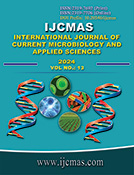


 National Academy of Agricultural Sciences (NAAS)
National Academy of Agricultural Sciences (NAAS)

|
PRINT ISSN : 2319-7692
Online ISSN : 2319-7706 Issues : 12 per year Publisher : Excellent Publishers Email : editorijcmas@gmail.com / submit@ijcmas.com Editor-in-chief: Dr.M.Prakash Index Copernicus ICV 2018: 95.39 NAAS RATING 2020: 5.38 |
An experiment was conducted to study the groundwater recharge through rainfall and artificial recharge structures in selected dry well at different locations of Ambedkarnagar District, UP. The results of the study concluded that the autoregressive time series model can be used effectively to predict the pre and post monsoon ground water level the better predictions will help the Farmers and policy makers to optimally utilize the groundwater resources. It is providing the solutions to execute the artificial recharge structure at the appropriate locations with best geological condition to enhance the recharge rate at least cost for control of declining groundwater level. It reveals that the stochastic auto regressive lime series model is an effective tool for management of ground water resource in Ambedkarnagar district of Uttar Pradesh state.
Agarwal, C. K., Bhargava, A. N., Singh, P. R. and Chhabra, S. S. (2009) Estimation of recharge to groundwater due to return flow of irrigation in Eastern Yamuna Canal Command Area using nuclear technique – A case study. In: Proceedings of All India Seminar on Groundwater Investigation, Management and Geophysical Techniques, Lucknow, December 11-12, 1990. pp. T-IV/44-48.
Bouwer Herman (2002). Artificial recharge of groundwater: hydrogeology and engineering. Hydrogeology Journal vol. (10), 121–142. http://dx.doi.org/10.1007/s10040-001-0182-4
Islam M. N., Chowdhury A., Islam K. M. and Rahaman M. Z., (2014) Development of rainfall recharge model for natural groundwater recharge estimation in GodagariUpazila of Rajshahi district, Bangladesh. American Journal of Civil Engineering, 2(2): 48-52. https://doi.org/10.11648/j.ajce.20140202.16
Jansa, O. V., (1952) Artificial replenishment of underground water, Proe. International Water Supply Association, 2nd Congress, Paris, 105 p.
Mansouri B. E. and Mezouary L. E., (2015) Enhancement of groundwater potential by aquifer artificial recharge techniques: an adaptation to climate change. Hydrological Sciences and Water Security: Past, Present and Future (Proceedings of the 11th Kovacs Colloquium, Paris, France). IAHS Publ. 366. https://doi.org/10.5194/piahs-366-155-2015
Peera D. G. and Kumar M. K., (2015) Assessment of groundwater resources: a case study. International Journal of Advances in Engineering & Technology, Dec., 2015. ISSN: 22311963.
Ravichandran S., Kumar S. S. and Singh L., (2011) Selective Techniques in Artificial Groundwater Recharge through Dug well and Injection well methods. International Journal of ChemTech Research, 3(3):1050-1053.
Russo, T. A., Fisher, A. T., & Lockwood, B. S. (2014). Assessment of Managed Aquifer Recharge Site Suitability Using a GIS and Modeling. Groundwater. https://doi.org/10.1111/gwat.12213
Saha D and Marwaha S (2016) Aquifer Mapping and Management Programme in India. Bhbujal Manthan -2: National Dialogue on Aquifer mapping and Ground Water Management. Central Ground Water Board. Ministry of Water Resource, River Development & Ganga Rejuvenation. Government of India.pp.1-12.
Swami, V. A. and Kulkarni, S. S. (2016). Simulation of Runoff and Sediment Yield for a Kaneri Watershed Using SWAT Model. Journal of Geoscience and Environment Protection, 4(01):1-15 https://doi.org/10.4236/gep.2016.41001
Todd, D. K., (1959) Annotated bibliography on artificial recharge of groundwater through 1954, Water Supply Paper, U.S. Geological Survey, 1477, 115 p. https://doi.org/10.3133/wsp1477
Tripathi A., Mishra A. K. and Verma G. (2016) Impact of preservation of subsoil water act on groundwater depletion the case of Punjab, India. En.v Manage 58: 48-59. https://doi.org/10.1007/s00267-016-0693-3
 |
 |
 |
 |
 |